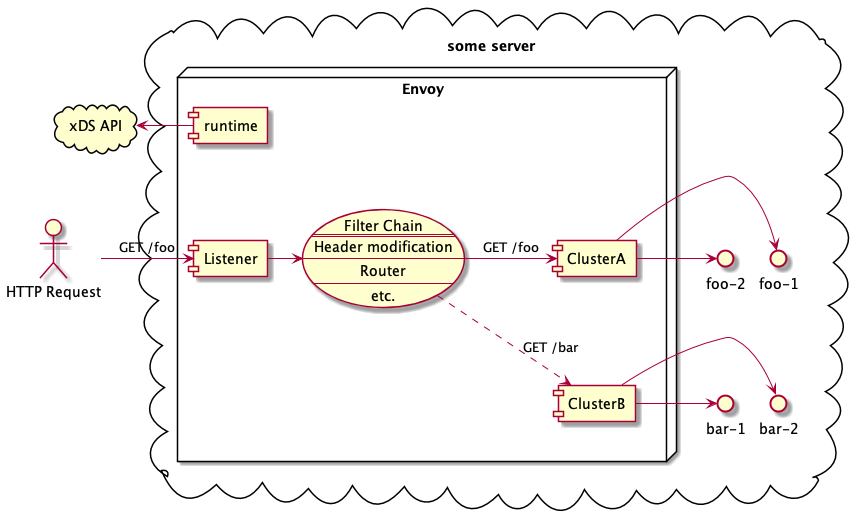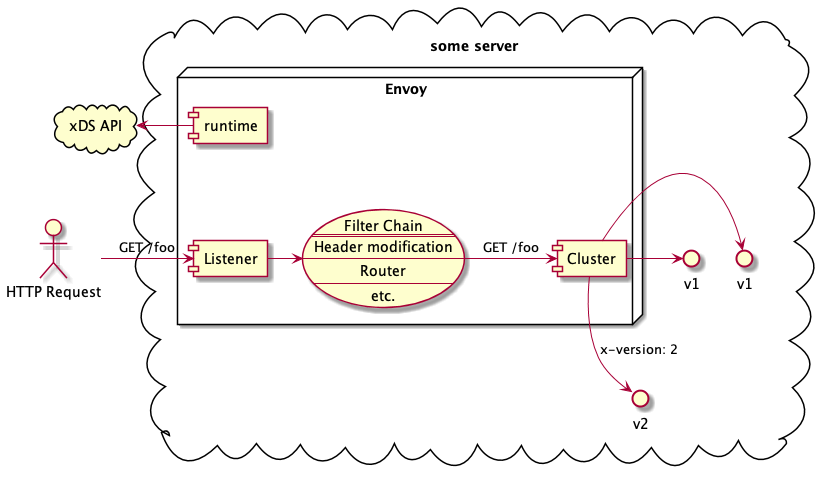Custom Envoy xDS server in Golang with Cluster Subsets
At work (at Q42, check it out) we started using Envoy for some use cases. Envoy is a very customizable proxy. Think of it as something like NGINX, but with more dynamic configuration possibilities (NGINX Plus probably also has these, but that is behind a paywall). In this post I’ll explore how you can dynamically configure it, via its control plane API called “xDS”.
Short Envoy intro

A standard Envoy configuration consists of “listeners”, each having “filter chains” with one or more “filters”. At least one often, because the “router” is also a filter. This router sends the traffic to a backend “cluster”, which is just a list of IP addresses. There are several ways of determining this list of IPs, one of which is resolving a hostname using DNS.
The picture above shows a simple example where two routes are defined, which each point to a different cluster, both containing 2 backend servers. This configuration is read from another server providing the xDS endpoint. An comparable example of this xDS implementation can be found here: envoyproxy/go-control-plane internal/example.
Note that Istio also uses Envoy as the underlying proxy layer of the service mesh. It uses this same xDS API to configure Envoy, which is injected beside each container as a sidecar. Given Istio’s endless features you can reason that this xDS API must be very flexible and extensible to support this large feature-set.
Cluster subsets
However simple aboves example, this post is about a more complex load balancing scenario: one where we have subsets of backend servers inside a cluster. Each of the cluster backends can serve us the desired service, but some of them might serve a specific alpha/canary version, or some have some other specific desired property.

The documentation about subsets is sparse. It does not show how to implement such a thing in xDS. I found it less than trivial, so I hope that this post might help you if you want to implement subsets. It boils down to two things:
- determining request metadata; the easiest way to do this is with a HTTP Filter called Headers-To-Metadata, but you can also use a WebAssembly filter or something more sophisticated via a call-out to a gRPC service.
- adding the metadata subset selectors to the cluster LbSubSetConfig
- adding the metadata key-value pairs to the cluster endpoints
The following code snippet shows how to, using static YAML configuration:
| # Requires Envoy >= 1.14. | |
| # Validate: | |
| # $ docker run -v $PWD:/data envoyproxy/envoy /usr/local/bin/envoy -c /data/config-equivalent.yaml | |
| # | |
| # Docs: https://www.envoyproxy.io/docs/envoy/latest/intro/arch_overview/upstream/load_balancing/subsets | |
| # Other examples: https://www.envoyproxy.io/docs/envoy/latest/configuration/overview/examples | |
| static_resources: | |
| listeners: | |
| - name: listener0 | |
| address: { socket_address: { address: "0.0.0.0", port_value: 80 } } | |
| filter_chains: | |
| - filters: | |
| - name: envoy.filters.network.http_connection_manager | |
| typed_config: | |
| "@type": type.googleapis.com/envoy.extensions.filters.network.http_connection_manager.v3.HttpConnectionManager | |
| codec_type: AUTO | |
| stat_prefix: ingress_http | |
| http_filters: | |
| - name: envoy.filters.http.header_to_metadata | |
| typed_config: | |
| "@type": type.googleapis.com/envoy.extensions.filters.http.header_to_metadata.v3.Config | |
| request_rules: | |
| - header: x-slice | |
| on_header_present: | |
| metadata_namespace: envoy.lb | |
| key: slice | |
| - name: envoy.filters.http.router | |
| route_config: | |
| name: local_route | |
| virtual_hosts: | |
| - name: local_service | |
| domains: ["*"] | |
| routes: | |
| - match: { prefix: "/" } | |
| route: { cluster: target, host_rewrite_literal: target } | |
| clusters: | |
| - connect_timeout: 1s | |
| name: target | |
| type: strict_dns | |
| http2_protocol_options: {} | |
| lb_subset_config: | |
| fallback_policy: ANY_ENDPOINT | |
| default_subset: { "slice": "default" } | |
| subset_selectors: | |
| - keys: ["slice"] | |
| fallback_policy: NO_FALLBACK | |
| load_assignment: | |
| cluster_name: target | |
| endpoints: | |
| - lb_endpoints: | |
| - metadata: | |
| filter_metadata: { "envoy.lb": { "slice": "target-1" } } | |
| endpoint: | |
| address: | |
| socket_address: | |
| address: target-1 | |
| port_value: 80 | |
| - metadata: | |
| filter_metadata: { "envoy.lb": { "slice": "target-1" } } | |
| endpoint: | |
| address: | |
| socket_address: | |
| address: target-2 | |
| port_value: 80 | |
| - metadata: | |
| filter_metadata: { "envoy.lb": { "slice": "target-1" } } | |
| endpoint: | |
| address: | |
| socket_address: | |
| address: target-3 | |
| port_value: 80 |
It was interesting figuring out how to convert this into xDS code. First of,
there are several xDS endpoints that you can implement. If you just need a
dynamic list of cluster endpoints (this is called EDS), then you only need to
implement that gRPC endpoint. The Envoy xDS control plane lib offers a
serverv3.Server struct that implements all of the xDS endpoints. Instead of
implementing all methods yourself, you hand it a snapshot of the desired YAML
resources and it will cache and serve those for you.
Another bit of the puzzle is that you have to use protobuf.Any for wrapping
all non-core typed_config fields. For example, the Header-to-Metadata
configuration needs to be marshalled into
Any.
The corresponding Go code can be found here:
- setting request metadata (
X-Sliceheader toslicemetadata): resource.go#L63-L71 - adding subset selectors to the cluster: eds.go#76-L84
- adding the key-value pairs to the cluster endpoints: [eds.go#L53-L58](https://github.com/hermanbanken/envoy-xds/blob/master/xds/eds.go#L53-L58]
The repository serves as a demo. It comes with a docker-compose.yaml so you can quickly build & run it yourself, and tweak it further.
Conclusion
Istio is a bridge too far for us now, due to the added complexity, but we can use a part of it by using the underlying proxy technology, Envoy. It allows us to define a very specific load balancing scheme, which - at work - has the potential to replace several components and make the architecture a lot simpler: less moving parts is both easier to reason about and also less error prone.
You can find the full source of this post at GitHub (hermanbanken/envoy-xds). If you have any questions or remarks, find me on Twitter or create an issue at GitHub.